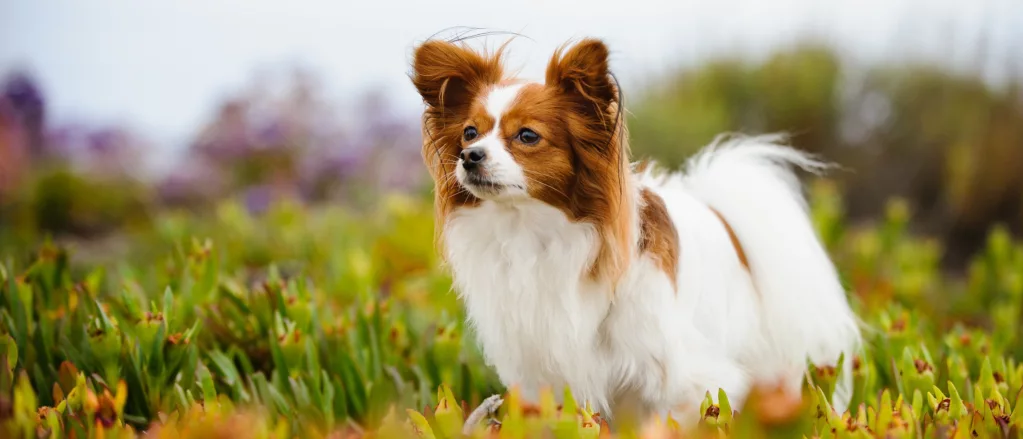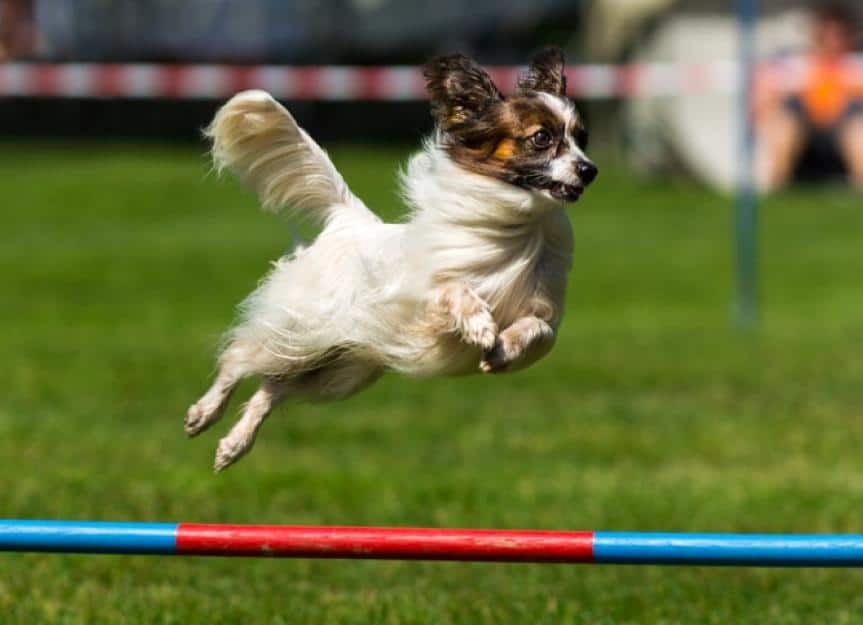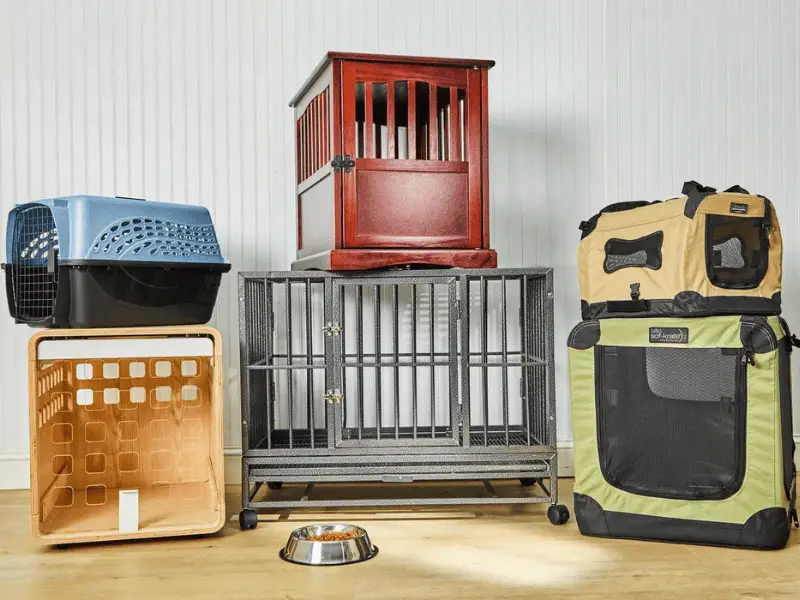There is no dispute that the Papillon dog size and body frame are small. Despite their petite frame, which typically measures between 8-11 inches tall at the shoulder and weighs between 5-10 pounds, they are among the most intelligent and trainable of all dog breeds.

While the Papillon is generally known for being a small breed, one surprising fact is that these dogs have a large brain capacity compared to their body size.
They’re often underestimated due to their size, but Papillons have historically performed well in obedience and agility trials, a testament to their large intellectual capacity relative to their physical size.
Papillon dogs are small and have huge personalities! Papillons come from France. They have butterfly-like ears and graceful looks, they are a sought-after choice for pet owners searching for a small buddy with lots of character.
Papillons are a toy breed and usually weigh 5-10 pounds.
Despite this, they are full of energy and very agile! Plus, they are clever and learn quickly; making them great for training and doggy sports.
A standout feature of Papillons is their long, silky coat. It comes in many colors and patterns. Regular brushing is needed to avoid tangles and knots. Additionally, they are friendly and love human company.
Overview of the Papillon dog breed
The Papillon dog breed – known for its butterfly wing-like appearance, plumed tail, and royal history – has captivated dog lovers worldwide.
In this overview, we will delve into these delightful canines’ fascinating characteristics and cultural significance, exploring their classification, common names, and the reasons behind their enduring popularity.
Join us as we uncover the captivating world of the Papillon breed and discover what makes them a small breed with a big personality.
Papillon’s butterfly wing-like appearance and plumed tail
Papillons are known for their butterfly-like wings and plumed tail. Their ears, either erect or drop, resemble a butterfly’s wings, thus the name. The tail adds to their grace and charm. Papillons have a royal past and have been popular pets for centuries.
Their butterfly-like wings are one of their defining features. The shape and position of their ears give the illusion of delicate wings, like a butterfly in flight. Also, the plumed tail adds elegance to their look when they move. These unique physical traits make Papillons stunning to look at.
Also, Papillons have a royal background and are much desired. They were cherished by nobility, seen as symbols of luxury and status because of their beauty and appeal.
Over time, they have become beloved companions. This lasting popularity is evidence of their desirable qualities and pleasant personality.
Moreover, Papillons belong to the toy dog group, and are seen in various kennel clubs with different names such as Continental Toy Spaniel (Papillon) or Phalene (drop-eared version).
These different names reflect minor variations in their ears, but not in their look or character. Whether with erect or drop ears, Papillons keep captivating hearts with their alluring appearance.
Whether adored for their visual beauty or admired for their friendly and alert personality, Papillons remain beloved pets with a small size but big personality.
Papillon’s royal history and Popularity
Papillon dogs have an amazing noble past and have been a top choice for dog fanatics. These wonderful pooches were favored amongst European royals and in Renaissance artwork. Their fame has held on through the centuries, and are now cherished buddies for people all over the world.
These tiny dogs, known for their butterfly-like wings and feathered tail, have won hearts with their regal pose. They were often seen accompanying high-class ladies at court, bringing a refined atmosphere. The Papillon’s unique look has made it a desirable breed among dog owners.
Papillons are also referred to as Continental Toy Spaniels or Squirrel Dogs, describing their miniature size and lively disposition. Despite their small size, these doggies possess a charm that’s hard to ignore. They’re versatile pals that can adjust to different lifestyles and living conditions.The extravagance of Papillons is mixed with their lasting appeal to dog keepers. From old aristocracy to modern households, these enchanting canines keep gaining love with their loving nature and smart temperament. Whether as a devoted companion or a showmanship performer, the Papillon’s beauty is unmistakable.
If you’re pondering welcoming this entrancing breed to your family, be sure to research and find a reliable breeder who puts the health and well-being of their pooches first.
By bringing home a Papillon, you will get a faithful companion and be a part of a long-standing custom that celebrates the radiance and royalty of these exceptional dogs. Don’t miss out on the joy that comes with having a Papillon around!
Papillon’s classification and common names
Papillons, also known as the butterfly dog, are a type of small dog. They have an eye-catching ‘butterfly wing’ look and a plumed tail. Plus, Papillons have an interesting history. They remain popular as companion animals.
The following table gives information on the Papillon’s breed group, country of origin, and alternative names:
| Classification | Common Names |
|---|---|
| Breed Group | Toy |
| Country of Origin | France |
| Other Names | Epagneul Nain Continental, Phalène (variety) |
The Papillon breed also has a variety called Phalène. It looks similar, but has a difference in the shape of its ears. The regular Papillon has erect or slightly tipped ears, whereas the Phalène variety features floppy or drop ears. This adds to the breed’s diversity and charm.
Papillon dog size and physical characteristics
Papillon dog size and physical characteristics – uncovering these charming canines’ size, weight, ear variations, and coat characteristics.
Size and weight of male Papillons
Male Papillons come in a range of sizes and weights. This contributes to their look and characteristics. Breed standard and genes determine size and weight.
Below is a table that displays the variations of male Papillons’ size and weight:
| Size Category | Weight Range (in pounds) |
|---|---|
| Toy | 3 – 5 |
| Miniature | 6 – 8 |
| Standard | 9 – 10 |
The average measurements may not be the same for every Papillon due to factors like genes, health, and nutrition.
Make sure to exercise your pup and give them a balanced diet. Ask your vet for dietary advice tailored to your Papillon’s age, breed, and activity levels.
Female Papillons may be tiny, but they’re as mighty as a horde of butterflies!
Size and weight of female Papillons
Female Papillons vary in size and weight. Generally, they’re smaller and lighter than the males. A table is provided with measurements for reference. We must note that genetics, diet, and health can affect their size and weight.
In addition, female Papillons have unique physical traits. Ears come in variations – some upright, others wispy. They also have a long, silky coat, with fringed hair that gives them an elegant look.
A story of Sarah and Daisy highlights the small size of female Papillons. When looking for a pup, Sarah needed a small breed due to living space. After research, she fell in love with Daisy, who was only 8 pounds when fully grown.
Due to Daisy’s size, Sarah could take her everywhere. Despite her small stature, Daisy was lively, playful, and full of joy!
In conclusion, female Papillons weigh from 5 to 10 pounds. They have physical characteristics such as different ear variations, and a long coat with fringed hair. Despite their size, they have big personalities making them great companions.
Papillon’s ear variations and wispy ears
Papillon dogs are renowned for their special ear variations and feathery ears. These traits contribute to their unique and beguiling looks. The Papillon’s ears can be straight and erect, resembling butterfly wings – adding to their charm.
Some Papillons may have longer locks on their ears, creating a wispy effect that boosts their elegant aura. The mixture of these features makes them eye-catching and classy.
It’s essential to note that these ear variations aren’t just aesthetical qualities. They also have a purpose. The Papillon’s straight and erect ears allow them to hear well, raising their responsiveness and alertness.
The longer hair on their ears may provide certain protection from external elements. These special ear variations are highly appreciated by aficionados and add to the breed’s popularity.
Interestingly, the Papillon breed’s history reveals that these ear variations have been around for centuries. Paintings from the 16th century depict small spaniel-type dogs with butterfly-like ears. This historic proof suggests that these ear variations were intentionally bred for over time, resulting in today’s distinct Papillon look.
Papillon’s coat and fringed hair
Papillons are adored for their beautiful coat and fringed hair. This breed is known for its long, silky hair that fringes around its ears, chest, and tail. This fringe gives them a unique and elegant look. Usually, their coat is straight and smooth, with no curls or waves. Regular brushing is essential to maintain it and avoid matting.
The Papillon’s coat is available in various colors, like white, black, red, sable, and brown. Some have markings or patches of color on their body or face too. The fringed hair enhances their beauty!
Grooming should be done weekly. Brushing removes loose hair and prevents tangles. Bathing is alright, but excessive bathing strips their natural oils. Cleaning their ears is essential too, since the long fringes can collect dirt or earwax.
These friendly and intelligent dogs make wonderful companions for individuals and families. Their coat and fringed hair will remain attractive and healthy with proper care and grooming. These features enhance the Papillon’s regal appearance.
The temperament of Papillon dogs
Papillon dogs are known for their small size, but their personality is anything but small. In this section, we will delve into the temperament of Papillon dogs, exploring their happy, friendly, and alert nature.
We will also discuss their suitability as companion dogs and shed light on their aggression tendencies, providing a comprehensive understanding of the Papillon’s captivating personality.
Description of the Papillon’s happy, friendly, and alert personality
Papillons are renowned for their lively, sociable, and attentive nature. Small in size, they have a cheerful and friendly temperament that makes them superb playmates. They’re always keen to please their owners, yearning for attention and adoration.
These dogs love people and get on well with kids, other pets, and strangers. Their empathy enables them to sense emotions, making them intuitive and compassionate companions. If you’re interested in learning more about this small breed with a big personality, check out the Papillon Dog Size article on AKC.org.
Moreover, Papillons are outstanding watchdogs. They detect any unusual noise or movement in the environment and bark to alert their owners of potential threats. Despite their diminutive size, they take their role as protectors seriously.
Furthermore, Papillons are intelligent and can be trained easily. They’re invigorated by mental stimulation and enjoy learning new tricks or taking part in activities. Inquisitive by nature, they actively explore their surroundings.
Papillons: the ideal companion, with a personality as vibrant as their butterfly-like appearance.
Papillon’s suitability as a companion dog
Papillons have an alert, friendly, and happy personality, making them great companion dogs. They form strong bonds with their owners and love being included in family activities. Plus, their small size and adaptability make them perfect for living in apartments.
They are also very intelligent and eager to please, making them easily trainable for therapy and dog sports. Papillons are very affectionate and great companions for all ages. They need lots of human interaction and love being part of the family’s daily routine.
Their small size allows them to join their owners on trips and outings. It is important to keep in mind that Papillons may show aggression if not socialized from an early age.
Early socialization with other animals, people, and various environments is key to making sure they become well-rounded companion dogs.
However, they can be gentle and well-behaved with proper training and socialization. Papillons have a lot of energy and require regular exercise. Walks, playtime, and interactive toys are great ways to meet their exercise needs.
Mental stimulation through puzzle toys or obedience training helps prevent issues like excessive barking or destructive chewing.
Papillon’s aggression tendencies
Papillons are known for their friendly and joyous personalities – they don’t usually display aggression. Small breed dogs are usually gentle and loving towards their owners and other animals.
- 1. Not hostile, Papillons make great companion dogs.
- 2. Their friendly nature helps them socialize with children and other pets.
- 3. Though tiny, Papillons can be very protective of their owners without being aggressive.
In addition to their amiable temperament, they are also smart and agile. They learn easily and respond well to positive reinforcement. These qualities result in good behavior and lack of aggression.
Pro Tip: Even though Papillons are usually non-aggressive, a single dog may act aggressively if scared or threatened. It is essential to provide proper socialization, training, and a safe environment to guarantee a contented and well-mannered Papillon.
With Papillons, you’ll always be entertained – they bark, chew, dig, and snore their way into your heart.
Training and exercise needs of Papillons
Papillons, a small breed known for their big personalities, have specific training and exercise needs that require attention. From their learning ability to tendencies such as barking, chewing, digging, and snoring, we’ll explore how to address these behaviors effectively.
Additionally, we’ll discuss the exercise requirements of Papillons and why mental stimulation plays a crucial role in keeping them happy and healthy. So, let’s dive into the world of training and exercise for these delightful canine companions.
Papillon’s learning ability and tendency to bark, chew, dig, and snore
Papillons boast impressive intelligence and quickly learn commands. Yet, they may bark, chew, dig, or even snore.
- These pooches possess immense knowledge, making them apt for training. They easily comprehend commands and tricks.
- They may bark at perceived threats or excitement. Thus, it is essential to socialize and train them to control the noise.
- They may also chew on any object, but providing them with chew toys can help restrict this behavior.
- A natural impulse to dig in the ground is common in Papillons. To manage this, designate a digging area or provide mental stimulation activities.
- Their small respiratory systems and flat-faced structure may cause them to snore. Monitor their breathing and consult a vet if needed.
In spite of their size, Papillons are smart and excel in training. Therefore, owners must address barking, chewing, digging, and snoring via proper training and management.
My friend adopted a Papillon that excessively barked when someone approached the door. She trained the pooch using positive reinforcement techniques and could teach it alternative behaviors. This improved their bond and created a peaceful atmosphere at home.
Exercise requirements of Papillons and the importance of mental stimulation
Exercising is an essential part of caring for Papillons. These tiny dogs have lots of energy and need regular physical activity to stay healthy and stimulated. Stimulating their minds is as important as physical activity; this helps to prevent boredom and destructive behavior.
Papillons are great at being agile, due to their powerful hindquarters and well-muscled bodies. They love activities like walking, running, fetch and agility courses. Exercise keeps them fit both physically and mentally.
To meet the exercise needs of Papillons, it’s a good idea to get them involved in activities that challenge their minds. Puzzle toys, interactive games, and obedience training help to keep their minds sharp and focused.
Plus, socializing through playdates or trips to the dog park are also great ways to keep them mentally happy.
Physical exercise is important, but mental stimulation is also key in giving Papillons what they need. Tasks requiring problem-solving skills or teaching new tricks can provide mental challenges that keep them stimulated and entertained.
Grooming and maintenance of Papillons
With Papillon dogs, grooming and maintenance is a vital aspect of their care. From discussing the low-maintenance grooming needs to potential health issues like patellar luxation and eye problems, we’ll explore how to keep these adorable creatures in top shape.
Papillon’s low-maintenance grooming needs
Papillons’ low-maintenance grooming needs make them perfect for pet owners with a busy lifestyle. Their single-layer coat requires only regular combing to avoid tangles and matting. Bathing is only necessary if they get dirty.
Dental hygiene is especially important, as they’re prone to dental issues. Brushing their teeth regularly prevents plaque build-up and gum disease.
Plus, nail trims as needed to keep them comfortable. All these make caring for a Papillon easy, but you must watch out for patellar luxation and eye problems.
Potential health issues such as patellar luxation and eye problems
The Papillon pup is vulnerable to health troubles, e.g. patellar luxation and eye issues. These can decrease a doggy’s wellbeing and may need medical attention.
- Patellar luxation: This ailment shows when the kneecap slides off-centre. It causes soreness, and can be slight or extreme. Small breeds, like the Papillon, are more susceptible.
- Eye problems: Papillons are prone to eye conditions such as progressive retinal atrophy (PRA), cataracts, and glaucoma. PRA leads to sight loss, while cataracts and glaucoma cause pain and sight impairment.
These illnesses can be controlled with proper care and regular vet visits. It is wise for Papillon owners to be aware of these risks, so they can take steps to keep their pup’s wellbeing. It is advised to speak to a vet for advice on preventing or managing these health troubles in Papillons.
Papillon’s rich history and popularity
Papillons have a history that dates back to the 16th century. These tiny creatures were often seen as beloved companions of noblewomen in Europe. With their wing-shaped ears, they still capture the hearts of dog lovers.
These dogs have a unique combination of size and personality. Despite their small size, they are confident and charismatic. They are also intelligent and trainable, so they can excel in various dog sports and competitions.
Papillons can adapt to different environments and lifestyles. They are suitable for city apartments or rural settings. Their moderate energy also makes them great for walks in the park or playtime in the backyard.
These dogs have unique qualities. One is their long lifespan – some live up to 17 years. Their distinctive coat, silky fur and distinct markings, sets them apart from other small breeds.
If you want a small dog, consider a Papillon. They have a rich history, a wonderful personality, and an eye-catching appearance. They are intelligent, adaptable, and have a long lifespan. Don’t miss the chance to bring a Papillon into your life – you’ll be rewarded with happiness!
Final Thoughts on the Papillon Dog Size
The Papillon is a small pup with a mighty character. Though tiny, they have bundles of energy and an endearing, active nature. Intelligent and obedient, they make great show dogs – one of the smartest small breeds around!
Friendly and sociable, these dogs make great family pets, and their long, feathery coats and ‘butterfly’ ears make them an especially attractive addition. In short, the Papillon is a fantastic choice for those looking for a mini, intelligent, and lively canine companion.
Some Facts About Papillon Dog Size:
- The Papillon is a small dog breed, with males weighing around 9-10 lbs and females weighing the same.
- Despite their small size, Papillons have a big personality and are known for their outgoing and happy temperament.
- Papillons are highly intelligent and trainable, making them versatile in various dog sports and competitions such as agility.
- The Papillon has a long lifespan of 12 to 15 years, allowing for many years of companionship with their families.
- Papillons have been favored by royalty and artists for centuries due to their unique appearance, including their distinctive butterfly-like ears.


